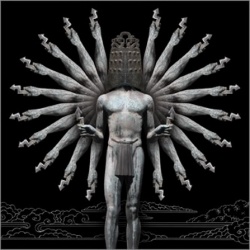Chinese Buddhist philosophy:Earliest developments
The first undisputed reference to Buddhism in China is an edict by Emperor Ming to Liu Ying, king of Qu, in the year ad 65, which mentions sacrifices performed by the king to Buddha as well as favourable treatment for Buddhist monks and laymen; the edict also identifies King Liu Ying as a follower of Huang–Lao Daoism. For the next few centuries, the Chinese continued to view Buddhist texts and practices as a part of or supplement to Daoism. Buddhism seemed to share important issues with the types of Daoism practised in this period, including the metaphysical primacy of emptiness, meditation techniques, dietary and behavioural disciplines, afterlife theories connected to moral and behavioural discipline, expansive pantheons and cosmologies, striving for the soteriological transformation of the ordinary human condition, rigorous and subtle intellectual traditions, and magical and yogic powers. These affinities, however, were more apparent than real, since the Buddhist approaches to these issues usually differed sharply from their Daoist counterparts, though Buddhists did not assert their distinctiveness until the fifth century.
Buddhist monks and businessmen representing a variety of Buddhist schools and disciplines continued to arrive in China, establishing Buddhist communities in Loyang and elsewhere. It took several centuries for the Chinese to notice how disparate the various forms of Buddhism really were. Initially the Chinese were most interested in Buddhist meditation techniques, including chanting and visualizations, which they adopted as supplements to Daoistic techniques. Daoism held out the promise that one could become a sage or perfected person, or even an immortal, but the exact details of how to accomplish this transformation remained elusive and vague. In comparison to many of the Daoist texts which were esoteric, hard to find, and frequently obscure in presentation, Buddhist texts seemed systematic and detailed, providing step-by-step procedures for practitioners.
Along with meditation manuals, the earliest Buddhist texts to become popular in China were Āvadana materials (legends of the Buddha and Buddhist heroes) and the Perfection of Wisdom Scriptures (Prajñāpāramitā Sutras). About half a dozen schools formed around varying interpretations of the Perfection of Wisdom Scriptures, mixing ideas found in these and other Buddhist texts with concepts prominent among Chinese intelligentsia. One Prajñā school, called the Original Nothingness school (Benwu), adopted a neo-Daoist cosmology: everything has emerged from a primordial, original emptiness, and everything returns to that void. This was a thorough misconstrual of Buddhist emptiness (see Buddhist concept of emptiness). Another school, called the Mind Empty school (Xinwu), equated the primordial Nothing with the nature of mind (see Zhi Dun). Each of the Prajñā schools managed either to promote a metaphysical substantialized emptiness which they opposed to form, or smuggle an eternal self or spirit into their formulations, despite Buddhism’s emphatic rejection of the notion of permanent selfhood.
Dao’an (ad 312–85) criticized the Prajñā schools, challenging their faithfulness to authentic Buddhist positions as well as the translation methodologies behind the texts they and other Chinese Buddhists had come to rely on. In particular, he criticized the practice of ‘matching the meanings’ (geyi), by which translators seeking Chinese equivalents for Indian Buddhist technical terms and concepts borrowed heavily from Daoist literature. This ‘matching of meanings’ was a mixed blessing. Packaging Buddhist ideas in familiar terms made them amenable and understandable, but the ‘matches’ were often less than perfect, distorting or misrepresenting Buddhism. For instance, early translators chose a well-known Daoist and Confucian term, wuwei (nondeliberative activity), to translate nirvāṇa. Arguably, wuwei and nirvāṇa represent the teloi of Daoism and Buddhism, respectively, but it is not obvious that they denote the same telos (see Daoist philosophy §6; Nirvāṇa). Later, to emphasize the uniqueness of Buddhist nirvāṇa, translators dropped wuwei in favour of a transliteration, niepan. Wuwei was retained to render another important Buddhist notion, asaṃskṛta (unconditioned). The semantic connotations of Daoist wuwei and Buddhist wuwei, while possibly overlapping in some senses, were nonetheless quite distinct: for Daoists it meant a mode of interacting effortlessly and naturally with the world, while for Buddhists it denoted something unaffected by causes and conditions, that neither arose nor ceased. Chinese readers inevitably came to conflate the semantic ranges of such terms, which over the centuries led to some distinctively Chinese Buddhist concepts. After Dao’an, Chinese Buddhism asserted its distinctiveness from native Chinese traditions and Buddhists adopted increasingly critical hermeneutic approaches to translation.
Source
LUSTHAUS, DAN (1998). Buddhist philosophy, Chinese. In E. Craig (Ed.), Routledge Encyclopedia of Philosophy. London: Routledge. Retrieved May 21, 2013, from http://www.rep.routledge.com/article/G002SECT2
